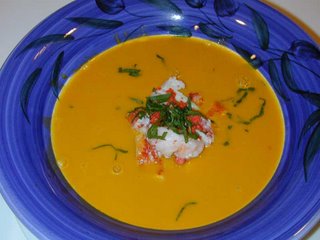
Carrot, Parsnip & Celery Root Soup
This soup has its "roots" in the Chantenay Carrot Soup made by chef Gabriel Frasca of Straight Wharf in Nantucket (and formerly Spire and Radius in Boston). His soup has a gorgeous, almost Day-Glo orange color and an equally amazing taste. The first time I had it, I found it to be so rich that I was sure it was filled with butter and cream. To my surprise, it contains neither and its richness is purely the concentration of carrots. I learned how to make the soup at home, and it came out just as luscious as when Gabriel makes it. Although I love the purity and simplicity of the original recipe, I couldn’t resist tinkering. This recipe is the results of my experiments. It trades off a little of the bright color and simplicity of flavor for more depth and complexity and slightly more sweetness from the parsnips. Both versions are great, it just depends on your mood and what you have on hand. Be forewarned, this recipe takes a little effort and special equipment (unless you have a source for vegetable juice), but it is so worth the effort! It floors everyone who tries it! This recipe makes six servings.
Ingredients
- 5 pounds chantenay or other great quality carrots
- 2 pounds of parsnips
- 1 medium celery root
- ¼ cup canola oil
- 1 large (1 pound) Spanish onion
- 1 ½ teaspoons curry powder (I use Sun Brand Madras Curry Powder)
- Salt and black pepper to taste
- Cooked lobster meat for garnish (optional)
- Finely shredded parsley
Method
Peel the carrots, parsnips and celery root, removing any discolored spots. Use 3 pounds of the carrots, 1 pound of the parsnip and half of the celery root for juicing. I have a Breville Juicer that I recommend highly! This effort will produce a little over 2 cups of juice.
 Slice the remaining carrots, parsnips and celery root into thin slices and reserve. Peel and thinly slice the onion.
Slice the remaining carrots, parsnips and celery root into thin slices and reserve. Peel and thinly slice the onion.To cook, use a wide, heavy-bottomed pot with a lid. I use a large round La Creuset pot. Add the oil and onions to the pot and cook, covered over medium heat until translucent. Add the reserved sliced vegetables and curry powder. Cook over low heat, stirring frequently to keep the vegetables from browning. After 10 minutes, season the mixture to taste with salt and pepper and add the vegetable juice. Cover and cook for 25 minutes, or until the vegetables are tender.
In small batches, puree the soup in either a bender or food processor. Strain the puree through a fine strainer (I have a large chinois with a wooden pestle for this purpose, but I’ll bet the soup would still taste great even if it were less finely strained.)
You can make the soup to this point ahead of time and reheat it before serving. When reheating, don’t let it boil as it degrades the silky texture. Just get it hot.

To serve, put in bowls and sprinkle with the parsley. Adding lobster meat puts the dish over the top! You don’t need much, a half pound of meat is plenty for six servings. In the picture, I had a little bright red roe from the cooked lobster that I also sprinkled over the soup.
For wine, try an Alsatian Gewürztraminer to pick up on the curry nuances, or a German Riesling Spatlese or Kabinet.






